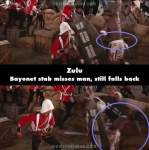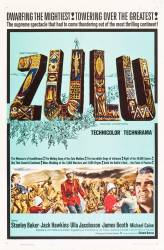Revealing mistake: When Mr Witt rides out of the Zulu camp in a 2 horse cart at the beginning of the movie, just before it exits, you can see it's a stunt double at the reins.
Continuity mistake: When Corporal Allen pulls Private Hitch off the ramparts when Hitch is shooting at Zulu's in the hills with his pith helmet on backwards, Hitch gets shot in the leg, and Allen pulls him in. Allen is shot in the chest, he clutches his chest, falls inside ramparts with blood underneath his clutching hand. When you see him after camera cut he is clutching the OTHER side of his chest.
Continuity mistake: In the scene where Michael Caine shoots at the cheetah, you can see the trainer in the clump of trees beckoning the animal on.
Factual error: In the climactic charge scenes in which the three ranks of British soldiers deliver volley after volley into the Zulu masses, the soldiers closest to the camera are correctly equipped with lever action Martini-Henry rifles but those further back in the line can be seen pulling up and back on bolt action rifles, wrong for the era.
Factual error: A bit of dramatic license was taken by the scriptwriters. Though portrayed in the film as a skiving drunkard, in real life Private Hook was considered a model soldier who was a lifetime teetotaller. Hook was receiving good conduct pay at the time of the battle.
Other mistake: In the scene when the Zulu warriors have broken through the roof in the hospital. The British make a hole and escape through it. You can clearly see the hole that they are going to cut open because it is a different color.
Factual error: The 24th is identified as the "South Wales Borderers." In 1879, the regiment was the 2nd Warwickshire. It did not become a Welsh regiment until 1881.
Factual error: Colour Sergeant Bourne was in fact rather a small man (which Nigel Green is not) and was actually, in his early 20s, the youngest colour sergeant in the British Army.
Factual error: Assistant Commissary Dalton, portrayed as a bit of an upper-class twit in the film, was in actuality a former infantry quartermaster sergeant and the most experienced soldier in the garrison. He helped to plan the defense.

Revealing mistake: During the first major Zulu attack, a warrior leaps down from the rampart and faces a British soldier (near the bottom right of the screen). The soldier lunges with his rifle and it's all too visible that his bayonet stabs to the side of the Zulu's chest.
Continuity mistake: The porters carrying the Leopard across the river pass by Baker. The next cut shows them approaching him.
Continuity mistake: After the Zulus' final charge which follows the rendition of "Men of Harlech", they appear on the hills round Rorke's Drift to give their salute to the garrison before leaving. In one shot, filmed from behind the Zulus, both buildings, church and hospital are standing even though the hospital burned down during the battle. Seconds later in the next shot of the post from the hills, only the church is standing and a column of smoke rises from the ruins of the hospital. I believe that some scenes were filmed of the Zulu Impi crossing the Buffalo River and marching to Rorke's Drift, but were cut from the film. The first shot mentioned above could be one of these.
Factual error: Lieutenants Chard and Bromhead were both rather elderly for their ranks (in their mid-30s) and Bromhead's career had begun to suffer due to a hearing problem. Like most members of the garrison, both had full beards.
Factual error: In history, the battle at Rourke's Drift was NOT ordered by Cetewayo. Cetewayo gave specific commands to his men not to attack any entrenched British positions; the Rourke's Drift assault was in fact spearheaded by one of his headstrong siblings eager to prove his warrior worth to his brother.
Deliberate mistake: This is a mistake which is a function of the limitation of the special effects at the time and what the censors would allow in the cinema but the wounds suffered by the Zulus do no justice to the horrific injuries that the Martini Henry rifle would have caused. The Martini Henry fired a big .45 inch soft nosed bullet that usually shattered on impact. It would have caused massive gaping wounds rather than the little red dots and trickles of blood shown on the Zulus and left many of them limbless as the bullets tore off arms and legs.
Factual error: In the actual battle the wagons were not tipped over, the space beneath was filled with mealie bags and ammunition boxes. This made the bayonet equipped rifles more effective against the much shorter assagais, since the assagai-armed Zulus could not engage without climbing onto the wagons.
Factual error: After the battle, the remaining Zulus left the field without making a sound, unlike the movie.
Continuity mistake: During the lull before the attack on the hospital, when Pte. Hook walks over to the doorway to speak to somebody, his suspenders are dangling down from his waist. A minute later, when the camera angle changes, his suspenders are suddenly up over his shoulders. Then, when the camera angle changes again, his suspenders are back down again.
Continuity mistake: Stanley Baker falls into the river. His legs and right arm go underwater. A moment later he is taking off a perfectly dry tunic.
Continuity mistake: If you look closely, many of the Zulus that die later reappear in the army.






Answer: Absolutely correct. This exact scene is in my DVD of Zulu. They may have changes when the TV version aired, but this definitely in the original.
stiiggy